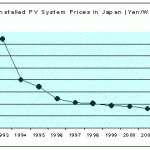
Know the truth!
From last last ten odd years the renewable energy has come into forefront. The reasons being several, starting with the famous Kyoto Protocol which brought all the countries on one platform.
This plaform was that of the carbon footprint and it’s aftereffect in form of, “The Global Warming”. This protocol tried to bind everyone by suggesting a guideline in controlling the individual carbon emission levels. Due to large disparity in each country’s per capita energy consumption and source of Power generation, an agreement is yet to be achieved .
Good part is that everyone has become aware of the issues of Global warming and has started thinking of mitigation. The focus has shifted to cleaner and greener energy has. This “Green Energy” is also called as renewable energy since by nature it is available in abundance and is renewable. There are several forms of renewable Energy.
Solar Photovoltaics
(when one uses the energy from sun to generate electricty)
Solar Thermal
(when one uses sun rays to heat water),
Wind Energy
(when the wind generates rotary power thru wind mills which further gets converted into mechanical power or elctrical power.
Wave/Tidal Power
(when the motion of waves converts the energy to elctrical power)
Bio Mass
(when various farms of bio degradable matrial gets converted to generate mechnaical or electrical power)
Of all the above the solar photovoltaics has been in the forfront of discussion and attention. Wind Energy has also not been left far behind by Solar Energy.
Both farms of energy have been recongnised as potent and have been put to use with some good effect. Wind energy has been mostly used for sailing support since ages. The dutch have been using the wind mills for water pumping and power generation. However fossile fuels like coal and oil have been used convetionally to generate power. There are large reserves of fossile fuels in various belts on earth but the rate at which these are being excavated and consumed, these may last only for a limited time.
In all these years “Solar Photo Voltaics (SPV)” was mostly relagated for scientifc research and “Solar Thermal” for heating or cooking purpose. SPV in todays form is not much old. Continued focus in reesearch and development has resulted into better efficiecies and lesser costs of production.

Even then SPV cost is still a bit out of sink as copared to current grid power costs coming from Fossile fues or Hydel (Hydro Electric), but in the span of last ten years the cost of solar power has come down signficantly. In Japan the SPV system cost has came down to one tenth in ten years. So is the case of the remaining world. The reason of reduction in costs is due to better quality cheaper supply of silican wafers due to high production volumes and also due to better efficiencies in manufacturing.
The SPV System costs are now going down much steaper due tp the further improvement of material costs and conversion efficiency. (Typically an amorphous Silican chips yield 5%-8% of conversion efficiency In case of Poly Crystalline Silican chip the value is 10%-14% and the high efficiecy Mono-Crystalline Silican chip yields over 20% of conversion efficieny). Over a period of time there has been a reduction in the wafer thickness from 200 microns to current 140-160 microns. (One micron being 10-6 of a meter). This has reduced the material cost .
In terms of “Price” the oil industry uses price per barrel as its unit of price measurement in case of a “Oil Barrel” , the solar energy industry typically uses price per Watt Peak (Wp) as its primary unit of measurement. The prices for high power band (>125 watts) solar modules has dropped from around $27/Wp in 1982 to around $4/Wp in 2002. Prices higher and lower than this are usually dependent upon the size of the order . As we speak the cost of the Watt Peak has come down to nearly $1.45/ WP.. This cost is expected to go down to about $1.0/ WP.
This opens up a very interesting comparision between SPV as a clean energy vs the conventional Energy derived from Fossile Fuels. The current Grid power (most of which) comes from Fossil fuel burning (be it Oil, Diesel, Coal or Gas) has a much larger Carbon foot print. In order to reduce the Carbon foot print of fossile fuel based technilogy large investments are required and that makes the cost or power high.
Countries such as India which has large reserves of coal still depend upon the coal fired plants due to easy and cheaper availability of coal but we have a big Carbon foot print. The main concern is pumping of large quantities of carbon gases in the atmosphere. In case we try cleaning up this exhaust before letting it out in the atmosphere (like is done in several developed countries), the cost of power generation would go up many fold.